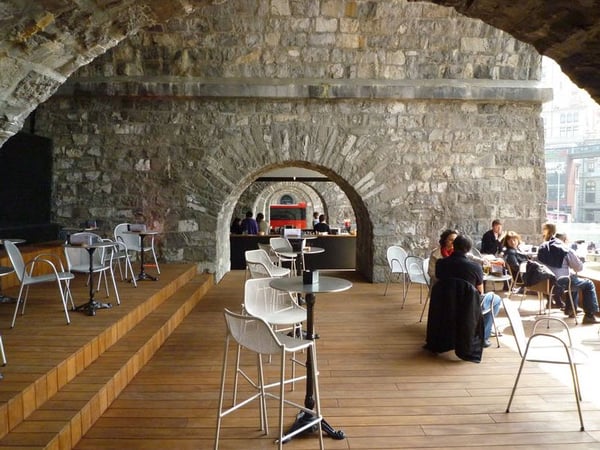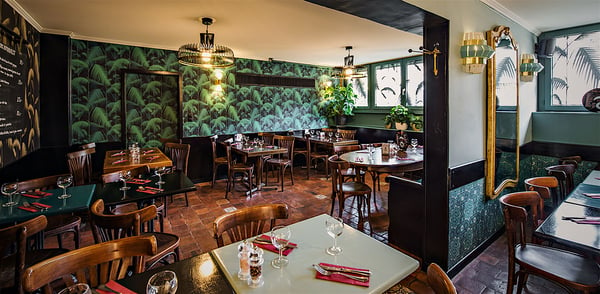On Monday 11th May, restaurants and bars were among the few public establishments in Switzerland allowed to reopen. The move was preceded by lengthy Federal Counsel regulations made available to all restaurateurs setting out the now rather familiar guidelines: 2m distances between tables, maximum 4 people at a table, strict hygiene measures, service staff in masks and required contact details of each customer.
Some noise was made about whether the move had come too soon, since initially the Swiss government had suggested reopening around early June. But with the Swiss Germans claiming fewer Covid-19 cases and eager to lift the lockdown, the Swiss French and Italians followed suit despite their higher virus numbers and added concerns about getting the safety measures right.
From speaking to a variety of bar and restaurant owners in the French-speaking Romandie region, many of them were torn between the joy of reopening and the fear of further losses. For spacious restaurants with both indoor and outdoor capacity, the new regulations (assisted by the clement spring weather) meant that a decent turnaround of customers could be assured despite the average 50% reduction in tables. However, those limited to just indoor space, especially the smaller ‘bijou’ eateries, found that they had drawn the short straw: was it going to be worth their while to risk reopening with such little to offer and equally little to gain? Not to mention the retraining of staff, reconfiguring the menu and the food supply, as well as the cost of implementing the new hygiene measures.
Thierry Wegmuller, manager of indoor restaurant Le Java and outdoor bar Les Arches in central Lausanne, describes in detail how the government measures have been impacting his business.
 Thierry Wegmuller (Image Credits: Paris Match Suisse)
Thierry Wegmuller (Image Credits: Paris Match Suisse)
1. How did you find the regulations of the Swiss Federal Counsel? Were any of them difficult to implement?
I agree with the distancing of tables and strict hygiene measures. The wearing of masks is optional, but all my staff choose to wear one as a sign of respect and safety towards our clientele. I do have a problem with having to close up at midnight. It’s bad enough dealing with the loss of revenue due to the reduction of tables, but then to rob us of a few extra hours feels unfair and illogical. I also think that the maximum number of 4 people around the table is rather low, I hope that it will soon be increased to 10. The taking down of every customer’s phone number has been thankfully contested and deemed unworkable; it would certainly have proved impossible to implement at Les Arches with people just stopping by for a quick drink and then leaving after a few minutes.

Les Arches, Lausanne (Image Credits: Les Arches)
2. Does the reduced amount of tables and customers make re-opening a viable option for you?
Let’s be honest, many of us are not reopening for financial reasons. Few of us are set to make any profit with this 50% capacity reduction. Personally, I’m opening for social reasons: I want my staff to feel busy again and give my customers an excuse to get out of the house. Regaining clientele trust and loyalty must come before any regaining of profits.
3. What’s the difference in turnout between your indoor restaurant and your outdoor bar?
Les Arches, essentially an open-air drinking spot in the center of town, has seen a great turnout, especially in young people eager to regain their social freedom. In addition, it’s considered a ‘safer’ option because of being outside and hence, easier to keep the required distance, without any air conditioning or sense of spatial confinement. It’s been a pleasant surprise, although the income is not quite as it was pre-lockdown. Le Java has a 40% table reduction and is just beginning to welcome a few more customers every day.

Le Java, Lausanne (Image Credits: Le Java)
4. Did you make any of your staff redundant during lockdown?
We chose not to lay off any of our staff. During confinement, they were all on state benefits, (RHT: reduction horaire travail). The bottom line in these crisis times is rooted in the pre-existing condition of your business: a healthy restaurant will survive if it was making a steady profit; in this case it makes no sense to cut your staff, it will only hinder you when things pick up again. However, the businesses that were already in trouble pre-pandemic will not survive in these conditions.
5. Did you rely on takeaways and home delivery?
No, we decided to totally shut down the kitchen during lockdown, besides, our menu at Le Java is not really catered for takeaways. However, now that our kitchen has reopened, we are collaborating very successfully with Uber Eats and Smood for home delivery of certain dishes. This is one positive aspects in the F&B industry that has come out of the pandemic.
6. How would like this period of deconfinement to be managed?
It’s important to maintain a positive attitude, re-establish trust and above all not feel guilty about wanting to re-engage in social activity. If one is taking the necessary precautions, the fear of contaminating others or being contaminated should not take over. We are likely to cause more damage to ourselves by cutting off our innate convivial, social natures. My job is not just to sell food and alcohol, I like to think of myself as a provider of joy, emotions, encounters. I’m a creator of energies and exchanges. For me, social relations are of the utmost importance and am committed to nurturing them for as long as I possibly can.
Conclusion
This situation pushes restaurants to rethink their entire operations’ process: redefine all touchpoints with clients, optimize them according to the situation and develop new options such as the successful takeaway model.
The use of a ‘service blueprint’ could be a handy strategic instrument in this post-pandemic climate, helping to re-create customer loyalty based on their expectations and perceptions. For example, a multi-dimensional research tool like ‘Servqual’, composed of 5 dimensions - Reliability, Responsiveness, Tangibles, Assurance and Empathy - can be adjusted to adapt to the Covid-19 parameters.
To quote Wegmuller, “Regaining clientele trust and loyalty must come before any regaining of profits”, hence, demonstrating optimal adaptation to the new security measures while at the same time showing commitment to the human, social nature of hospitality must surely be the way forward.






